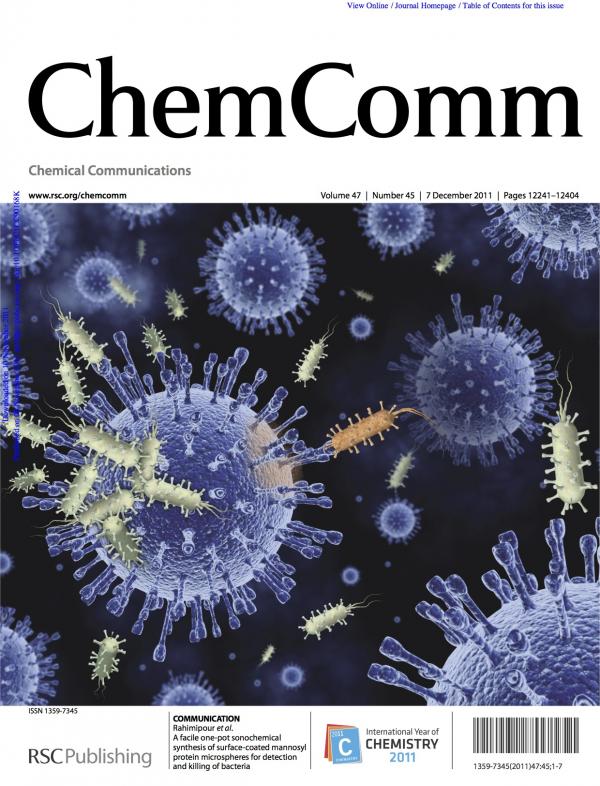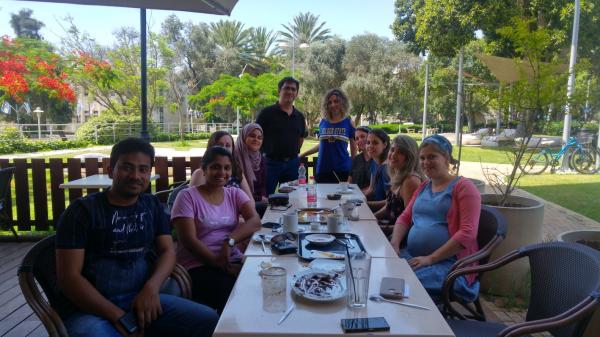
Prof. Shai Rahimipour
CV
Education
1990 - 1993 B.Sc., Chemistry - Bar-Ilan University, Ramat-Gan, Israel
1993 - 2001 M.Sc./ Ph.D. (combined), Organic Chemistry and Neurobiology, The Weizmann Institute of Science, Rehovot, Israel. Subject: Potential Cytotoxic Derivatives of Gonadotropin-Releasing Hormone (GnRH): Synthesis and Biological Evaluation. Supervisors: Prof. Mati Fridkin and Yitzhak Koch, Department of Organic Chemistry and Neurobiology.
2001 – 2003 Post-Doctoral Research Fellow, Chemistry and Photobiology, The Weizmann Institute of Science, Rehovot, Israel. Subject: Design, synthesis and biological evaluation of Hypericin and its analogs as potential agents for photodynamic therapy (PDT). Supervisor: Prof. Yehuda, Mazur
2003 - 2006 Post-Doctoral Research Fellow, Chemistry, The Scripps Research Institute, La Jolla, California. Subject: Self-assembled cyclic D,L-a-peptide and cyclic D,L-a-glycopeptides nanotubes as antibacterial and anticancer agents. Supervisor: Prof. M. Reza Ghadiri
Positions
2006 - 2014 Senior Lecturer, Department of Chemistry, Bar-Ilan University.
2014 - Present Associate Professor, Department of Chemistry, Bar-Ilan University.
Other professional activities
2007 - present Member in editorial board of ARKIVOC Journal.
2007 - 2008 Organizing Committee of the 6th Medicinal Chemistry Conference, The Weizmann Inst. of Science.
2014 Organizing Committee ofFunctional Peptide and Protein Nanostructures, May 25th -28th, 2014, Tzuba Hotel, Kibbutz Tzuba, Israel
Awards and fellowships
2010 Christians for Israel Chair in Medical Research, Self-assembled cyclic D,L-a-peptides as potent neuroprotective agents.
2009 The Elias, Genevieve and Geogianna Atol Charitable Trust, Cyclic glycopeptides with anticancer and anti-metastasis activity,
2003 Human Frontier Science Program (HFSP) long-term postdoctoral fellowship.
2002 Fulbright Postdoctoral fellowship as a supplementary award.
2000 CaP CURE award for proposed research on new drug discovery.
1999 ESCOM award for most outstanding poster relevant to drug discovery.
1999 American Peptide Society travel grant for the research presented at the 16th American Peptide Symposium.
1998 Fellowship of Distinction for outstanding achievement in studies and research, the Feinberg Graduate School of the Weizmann Institute of Science.
Research
One of the major goals of my group is to better understand and treat disorders that are linked to aberrant protein folding and assembly. Our research strategy is interdisciplinary, aiming at utilizing self-assembly processes to design new modalities for arresting amyloid formation in different diseases. We also use self-assembly processes to enhance biological activity by inducing multivalency. The main thrust of my group’s research is summarized below.
Drug Discovery, Design, and Delivery Research for Amyloidogenic Diseases. My group seeks to develop a supramolecular-based platform that can be used as a general scaffold for the design and discovery of novel anti-amyloidogenic compounds with potential application in the treatment of various amyloidogenic diseases, such as Alzheimer’s disease, Parkinson’s disease and type II diabetes. Very recent biochemical and biophysical studies have shown that pathogenic amyloids share common structural and functional features despite being composed of different proteins and amino acids. The similarities between the different amyloids are so immense that soluble aggregates of diverse amyloidogenic proteins, such as insulin, islet amyloid polypeptide, and a-synuclein, can cross-react with each other and be equally recognized by polyclonal antibodies raised against prefibrillar assemblies of amyloid b (Ab) peptides, which are responsible for Alzheimer’s disease. Astonishingly, we have recently found that there are great structural and functional similarities between Ab and the self-assembled cyclic D,L-a-peptides, which lead the latter to cross-react with Ab and modulate its aggregation and toxicity. Moreover, we have shown that the self-assembled cyclic D,L-a-peptides may interact also with other pathogenic amyloids, such as a-Syn and insulin, and inhibit their aggregation and toxicity too. We believe that these studies may shed light on the etiology of misfolded proteins and provide additional insights that can be used to tackle poorly understood topics in the field of misfolded protein diseases, such as the infectious nature of the amyloids and their ability to spread from cell-to-cell. These insights may eventually unravel the mechanism by which proteins begin to misfold to form toxic intermediates, and enhance our ability to intervene in such processes.
Leshem, G., Richman, M., Lisniansky, L., Antman-Passig, M., Habashi, M., Gras̈lund, A., Wärmländer, S. K. Rahimipour, S. Photoactive chlorin e6 is a multifunctional modulator of amyloid-β aggregation and toxicity via specific interactions with its histidine residues. Chem. Sci. 2018, 10, 208-217
Belostozky, A.; Richman, M.; Lisniansky, E.; Tovchygrechko, A.; Chill, J. H.; Rahimipour, S. Inhibition of tau-derived hexapeptide aggregation and toxicity by a self-assembled cyclic d,l-alpha-peptide conformational inhibitor. Chem. Commun. 2018, 54, 5980-5983.
Frenkel-Pinter, M., Richman, M., Belostozky, A., Abu-Mokh, A., Gazit, E., Rahimipour, S.*, Segal, D.* Selective inhibition of aggregation and toxicity of a Tau-derived peptide using its glycosylated analogs. Chem. Eur. J. 2016, 22, 5945-5952 (Cover).
Chemerovski-Glikman M., Rozentur-Shkop E., Richman M., Grupi A., Getler A., Cohen H.Y., Shaked H., Wallin C., Wärmländer S.K., Haas E., Gräslund A., Chill J.H., Rahimipour S. Self-assembled cyclic D,L-α-peptides as generic conformational inhibitors of the α-synuclein aggregation and toxicity: in vitro and mechanistic studies. Chem. Eur. J. 2016, 22, 14236-14246.
Wilik, S., Richman, M., Chemerovski, M., Wärmländer, S., Wahlström, A., Gräslund, A., Rahimipour, S. Anti-amyloidogenic self-assembled cyclic D,L-α-peptides: In vitro and mechanistic studies. J. Am. Chem. Soc. 2013,135, 3474-3484.
Chemerovski, M., Belostozky, A., Richman M., Rahimipour, S. Structure-Based Study of Antiamyloidogenic Cyclic D,L-α-Peptides. Tetrahedron, 2014, 70, 7639-7644.
Developing New Chemical Methods to Induce Multivalency – Application in the Field of Amyloidogenic Diseases Research. My group is also involved in developing new chemical methods to induce a multivalency effect, which is frequently used by nature to dramatically increase the bioactivity of ligands with low individual activity. These methods include the development of a new and straightforward sonochemical method to generate nano- and micro-sized particles bearing multiple copies of a bioactive elements covalently attached to their surface. We have used this technology to show that particles expressing multiple copies of the peptide KLVFF can strongly bind Ab, inhibit its aggregation, and reduce its cytotoxicity. We also found that the anti-amyloidogenic activity of these particles is significantly higher than that of an equimolar concentration of soluble KLVFF—most probably because of the multivalent presentation of the KLVFF peptide. We also showed that such surface-modified nanoparticles can dramatically reduce the inflammation associated with Ab. Initial in vivo toxicity experiments on mice and rats suggest that the particles are biocompatible even after intravenous injection of large doses. Bio-distribution and pharmacokinetic studies are now in progress.
Richman, M., Wilk, S., Skirtenko, N., Perelman, A., Rahimipour, S. Surface-Modified Protein Microspheres Capture Amyloid-β and Inhibit its Aggregation and Toxicity. Chem. Eur. J. 2011, 17, 11171-11177 (Cover)
Richman, M., Perelman, A., Gertler A., Rahimipour, S. Effective Targeting of Aβ to Macrophages by Sonochemically Prepared Surface-Modified Protein Microspheres, Biomacromolecules 2013, 14, 110-116.
Richman M. and Rahimipour S. Surface modified proteinaceous spherical particles and uses thereof, PCT/IB2012/054037
Utilizing Multivalency in the Field of Infectious Disease Research. We also used the multivalency effect induced by surface-modified particles to develop new modalities against bacterial and viral infections. In one example, we showed that the multivalent presentation of mannose on the surface of protein particles can cause bacteria that express mannose-binding receptors to tightly bind to the surface of the particles and inducing agglutination, which was used to detect (sense) low number of bacteria in solution. Moreover, we showed that loading the particles with the common antibacterial drug tetracycline significantly enhanced the antibacterial activity of the encapsulated drug. Enhanced drug activity was also observed when the surface of the particles was modified to express multiple copies of mercaptoethane sulfonate to inhibit HSV-1 infection.

Skirtenko, N. Richman, M., Nitzan, Y. Gedanken, A. Rahimipour, S. A facile one-pot sonochemical synthesis of surface-coated mannosyl protein microspheres for detection and killing of bacteria. Chem. Commun. 2011, 47, 12277-12279 (Cover).
Baram-Pinto, D., Shukla, S., Richman, M., Gedanken, A., Rahimipour, S.*, Sarid, R*. Surface-modified protein microspheres as potential antiviral agents. Chem. Commun. 2012, 48, 8359-8361.
Exploring another direction, we utilized mussel adhesive protein mimics (polydopamine) to modify different surfaces with a two-sided adhesive coating. The modified surfaces were then subjected to nucleophilic reactions with various substances to induce different functionalities on the surface. Using this technology, we recently succeeded in covalently modifying a wide variety of substrates (including glass, metals and polymers (polystyrene and polypropylene)) with different antibacterial and anti-fouling agents (including antimicrobial peptides, quaternary amines, and antibacterial enzymes). We demonstrated that the modified surfaces could effectively kill bacteria on contact without leaching of the active substances from these surfaces. Such surfaces are invaluable for a multitude of purposes, including reducing the spread of many infectious diseases.
By combining the above polydopamine chemistry and sonochemistry, my team also succeeded in generating polydopamine nanoparticles that preserve all the characteristics of polydopamine. We utilized the reactivity of the nanoparticles toward different nucleophiles to introduce new functionalities onto the particles’ surfaces. More interestingly, we showed for the first time that the presence of Cu or Ag ions during sonochemical irradiation generates particles that exhibit potent antibacterial and antifouling activity, without inducing any toxicity to mammalian cells. These particles could potentially be painted onto a wide range of surfaces to inhibit bacterial growth.
Shalev, T., Gopin, A., Bauer, M., Stark, R.W., Rahimipour, S.Non-leaching antimicrobial surfaces through polydopamine bio-inspired coating of quaternary ammonium salts or an ultrashort antimicrobial lipopeptide. J. Mater. Chem. 2012, 22, 2026-2032
Yeroslavsky, G., Richman, M., Dawidowicz, L. Rahimipour, S. Sonochemically produced polydopamine nanocapsules with selective antimicrobial activity. Chem. Commun. 2013, 49, 5721-5723 (Cover).
Yeroslavsky G., Girshevitz O., Foster-Frey J., Donovan D.M., Rahimipour S. Antibacterial and antibiofilm surfaces through polydopamine-assisted immobilization of lysostaphin as an antibacterial enzyme. Langmuir 2015, 31, 1064-1073.
Yeroslavsky G., Lavi R., Alishaev A., Rahimipour S. Sonochemically-produced metal-containing polydopamine nanoparticles and their antibacterial and antibiofilm activity. Langmuir. 2016, 32, 5201-5012.
Yeroslavsky, G. and Rahimipour S. Polydopamine nanocapsules and uses thereof. Provisional Patent Application 2012
Utilizing Multivalency and Supramolecular Chemistry in the Field of Inflammatory Disease Research: Type II Diabetes and Multiple Sclerosis. Various aspects of oxidative cellular stress are associated with the pathogenesis of several devastating human diseases, including diabetes, Alzheimer’s disease, Parkinson’s disease, and multiple sclerosis. It is well known that the generation of reactive oxygen species (ROS) in abnormal amounts or an impairment of the cells’ anti-oxidative protective systems can lead to cellular and tissue damage.
We demonstrated that the multivalent presentation of histidine residues induced by the abiotic self-assembly of cyclic D,L-a-peptides can lead to the generation of multifunctional agents that catalytically decompose intracellular ROS and induce cell protection. In particular, we showed that treatment of muscle cells with such permeable His-rich cyclic peptides protects the cells against the oxidative stress that is induced by hyperglycemic conditions and increases the uptake of glucose from the periphery by increasing the translocation of GLUT1 and GLUT4. In neuronal cells, we were able to show that these peptides exhibit potent anti-inflammatory, anti-oxidant, and anti-excitotoxic activity, and protect the neurons against axonal damage. In a pilot study carried out in collaboration with Teva Pharmaceutical Industries Ltd., we were able to demonstrate that the discovered cyclic peptides exhibit potent neuroprotecting activity in an animal model of multiple sclerosis (experimental autoimmune encephalomyelitis) and significantly ameliorate the related symptoms.
Shapira, R., Rudnick, S., Daniel, B., Viskind, O., Aisha, V., Richman, M., Perelman, A., Chill, J. H., Gruzman, A., Rahimipour, S. Multifunctional cyclic D,L-α-peptide architectures stimulate non-insulin dependent glucose uptake in skeletal muscle cells and protect them against oxidative stress, J. Med. Chem. 2013, 56, 6709-6718.
Shapiro R. and Rahimipour S. Neuroprotective cyclic peptides, Provisional Patent Application, 2012.
Publications
- Rahimipour, S.; Weiner, L.; Fridkin, M.; ShresthaDawadi, P. B.; Bittner, S., Novel naphthoquinonyl derivatives: Potential structural components for the synthesis of cytotoxic peptides. Lett. Pept. Sci. 1996, 3, 263-274.
- ShresthaDawadi, P. B.; Bittner, S.; Fridkin, M.; Rahimipour, S., On the synthesis of naphthoquinonyl heterocyclic amino acids. Synthesis 1996, 1468-1472.
- Rahimipour, S.; Weiner, L.; Shrestha-Dawadi, P. B.; Bittner, S.; Koch, Y.; Fridkin, M., Cytotoxic peptides: Naphthoquinonyl derivatives of luteinizing hormone-releasing hormone. Lett. Pept. Sci. 1998, 5, 421-427.
- Yahalom, D.; Chen, A.; Ben-Aroya, N.; Rahimipour, S.; Kaganovsky, E.; Okon, E.; Fridkin, M.; Koch, Y., The gonadotropin-releasing hormone family of neuropeptides in the brain of human, bovine and rat: identification of a third isoform. FEBS Lett. 1999, 463, 289-294.
- Sack, I.; Balazs, Y. S.; Rahimipour, S.; Vega, S., Solid-state NMR determination of peptide torsion angles: Applications of H-2-dephased REDOR. J. Am. Chem. Soc. 2000, 122, 12263-12269.
- Yahalom, D.; Rahimipour, S.; Koch, Y.; Ben-Aroya, N.; Fridkin, M., Structure-activity studies of reduced-size gonadotropin-releasing hormone agonists derived from the sequence of an endothelin antagonist. J. Med. Chem. 2000, 43, 2824-2830.
- Yahalom, D.; Rahimipour, S.; Koch, Y.; Ben-Aroya, N.; Fridkin, M., Design and synthesis of potent hexapeptide and heptapeptide gonadotropin-releasing hormone antagonists by truncation of a decapeptide analogue sequence. J. Med. Chem. 2000, 43, 2831-2836.
- Braverman, S.; Zafrani, Y.; Rahimipour, S., Base catalyzed [2,3]-sigmatropic rearrangements of propargylic sulfonium and selenonium salts. Tetrahedron Lett. 2001, 42, 2911-2914.
- Chen, A. L.; Yahalom, D.; Laskar-Levy, O.; Rahimipour, S.; Ben-Aroya, N.; Koch, Y., Two isoforms of gonadotropin-releasing hormone are coexpressed in neuronal cell lines. Endocrinology 2001, 142, 830-837.
- Rahimipour, S.; Ben-Aroya, N.; Fridkin, M.; Koch, Y., Design, synthesis, and evaluation of a long-acting, potent analogue of gonadotropin-releasing hormone. J. Med. Chem. 2001, 44, 3645-3652.
- Rahimipour, S.; Bilkis, I.; Peron, V.; Gescheidt, G.; Barbosa, F.; Mazur, Y.; Koch, Y.; Weiner, L.; Fridkin, M., Generation of free radicals by emodic acid and its [D-Lys(6)]GnRH-conjugate. Photochem. Photobiol. 2001, 74, 226-236.
- Rahimipour, S.; Palivan, C.; Freeman, D.; Barbosa, F.; Fridkin, M.; Weiner, L.; Mazur, Y.; Gescheidt, G., Hypericin derivatives: Substituent effects on radical-anion formation. Photochem. Photobiol. 2001, 74, 149-156.
- Sack, I.; Balazs, Y. S.; Rahimipour, S.; Vega, S., Peptide torsion angle measurements: Effects of nondilute spin pairs on carbon-observed, deuterium-dephased PM5-REDOR. J. Magn. Reson. 2001, 148, 104-114.
- Chen, A.; Ganor, Y.; Rahimipour, S.; Ben-Aroya, N.; Koch, Y.; Levite, M., The neuropeptides GnRH-II and GnRH-I are produced by human T cells and trigger laminin receptor gene expression, adhesion, chemotaxis and homing to specific organs. Nature Med. 2002, 8, 1421-1426.
- Chen, A.; Kaganovsky, E.; Rahimipour, S.; Ben-Aroya, N.; Okon, E.; Koch, Y., Two forms of gonadotropin-releasing hormone (GnRH) are expressed in human breast tissue and overexpressed in breast cancer: A putative mechanism for the antiproliferative effect of GnRH by down-regulation of acidic ribosomal phosphoproteins P1 and P2. Cancer Res. 2002, 62, 1036-1044.
- Rahimipour, S.; Ben-Aroya, N.; Ziv, K.; Chen, A.; Fridkin, M.; Koch, Y., Receptor-mediated targeting of a photosensitizer by its conjugation to gonadotropin-releasing hormone analogues. J. Med. Chem. 2003, 46, 3965-3974.
- Rahimipour, S.; Palivan, C.; Barbosa, F.; Bilkis, I.; Koch, Y.; Weiner, L.; Fridkin, M.; Mazur, Y.; Gescheidt, G., Chemical and photochemical electron transfer of new helianthrone derivatives: Aspects of their photodynamic activity. J. Am. Chem. Soc. 2003, 125, 1376-1384.
- Di-Segni, S.; Giordano, C.; Rahimipour, S.; Ben-Aroya, N.; Koch, Y.; Fridkin, M., beta-Sulfonamido gonadotropin-releasing hormone analogs: synthesis and evaluation of several parent hormone properties. J. Pept. Sci. 2005, 11, 45-52.
- Nicolaou, K. C.; Zak, M.; Rahimipour, S.; Estrada, A. A.; Lee, S. H.; O'Brate, A.; Giannakakou, P.; Ghadiri, M. R., Discovery of a biologically active thiostrepton fragment. J. Am. Chem. Soc. 2005, 127, 15042-15044.
- Rahimipour, S.; Litichever-Coslovsky, N.; Alaluf, M.; Freeman, D.; Ehrenberg, B.; Weiner, L.; Mazur, Y.; Fridkin, M.; Koch, Y., Novel methyl helianthrones as photosensitizers: Synthesis and biological evaluation. Photochem. Photobiol. 2005, 81, 250-258.
- Fridkin, G.; Rahimipour, S.; Ben-Aroya, N.; Kapitkovsky, A.; Di-Segni, S.; Rosenberg, M.; Kustanovich, I.; Koch, Y.; Gilon, C.; Fridkin, M., Novel cyclic azo-bridged analogs of gonadotropin-releasing hormone. J. Pept. Sci. 2006, 12, 106-115.
- Motiei, L.; Rahimipour, S.; Thayer, D. A.; Wong, C. H.; Ghadiri, M. R., Antibacterial cyclic D,L-alpha-glycopeptides. Chem. Comm. 2009, 3693-3695.
- Rahimipour, S.; Gescheidt, G.; Bilkis, I.; Fridkin, M.; Weiner, L., Towards the Efficiency of Pharmacologically Active Quinoid Compounds: Electron Transfer and Formation of Reactive Oxygen Species. Appl. Magn. Reson. 2010, 37, 629-648.
- Skirtenko, N.; Tzanov, T.; Gedanken, A.; Rahimipour, S., One-Step Preparation of Multifunctional Chitosan Microspheres by a Simple Sonochemical Method. Chem. Eur. J. 2010, 16, 562-567.
- Skirtenko, N. Richman, M., Nitzan, Y. Gedanken, A. Rahimipour, S. A facile one-pot sonochemical synthesis of surface-coated mannosyl protein microspheres for detection and killing of bacteria. Chem. Commun. 2011, 47, 12277-12279 (Cover).
- Richman, M., Wilk, S., Skirtenko, N., Perelman, A., Rahimipour, S. Surface-Modified Protein Microspheres Capture Amyloid-β and Inhibit its Aggregation and Toxicity. Chem. Eur. J. 2011, 17, 11171-11177 (Cover)
- Shalev, T., Gopin, A., Bauer, M., Stark, R.W., Rahimipour, S. Non-leaching antimicrobial surfaces through polydopamine bio-inspired coating of quaternary ammonium salts or an ultrashort antimicrobial lipopeptide. J. Mater. Chem. In Press. DOI:10.1039/C1JM13994K.
- Baram-Pinto, D., Shukla, S., Richman, M., Gedanken, A., Rahimipour, S.*, Sarid, R*. Surface-modified protein microspheres as potential antiviral agents. In Press.
- Richman, M., Perelman, A., Rahimipour, S. Effective targeting of Ab to macrophages by sonochemically prepared surface-modified protein microspheres. Submitted for Publication.
Courses
Biochemistry (I and II)
Organic chemistry laboratory
Seminars in Bio-Organic Chemistry
Seminars in Organic Chemistry
Patents
1. Koch, Y., Fridkin, M., Rahimipour, S. GnRH conjugates comprising a photosensitizer for photodynamic therapy. PCT Int. Appl. 2004, 59 pp, WO 2004098629, A1 20041118, CAN 141:427990, AN 2004:995998
2. Koch, Y., Fridkin, M., Rahimipour, S. Synthesis of long-acting gonadotropin-releasing hormone analogs and therapeutic use thereof. PCT Int. Appl. 2004, 63 pp, WO 2004030687, A1 20040415, CAN 140:31565, AN 2004:310981
3. Richman M. and Rahimipour S. Surface modified proteinaceous spherical particles and uses thereof, PCT/IB2012/054037
4. Yeroslavsky, G. and Rahimipour S. Polydopamine nanocapsules and uses thereof. Provisional Patent Application 2012
Research Group
Current Members:
Dr. Michal Richman, Rresearch Associate
Dr. Akhila Vishwan, Postdoctoral fellow (together with Prof. Jordan Chill)
Dr. Sudipta Senapati, Postdoctoral fellow
Elvira Lisniansky, Ph.D. Student
Maram Habashi, Ph.D. Student
Mykhailo (Misha) Diachkov, Ph.D. Student
Yael Sa-nes Blayberg, M.Sc. Student
Adan Marzouqe, M.Sc. Student
Merav Popko-Karkover, M.Sc. Student

Past Members
Sara Wilk
Natalie Skirtenko
Dr. Anna Gopin
Dr. Kamesh Ayasolla
Vered Aisha
Tal Shalev
Guy Leshem
Merav Pasig
Safra Rudnick-Glick
Renana Shapira
Michal Yaniv
Marina Chemerovsky, Ph.D. Student
Gil Yeroslavsky, Ph.D. Student
Pini Hasin, Ph.D. Student
Anna Belostosky, M.Sc. Student
Shira Carmi, M.Sc. Student
Anastasia Tovchygrechko, M.Sc. Student
Coral Malka, M.Sc. Student
Natalie Monayer, M.Sc. Student
Last Updated Date : 26/02/2024



